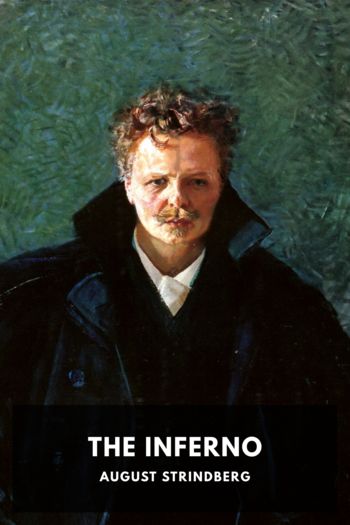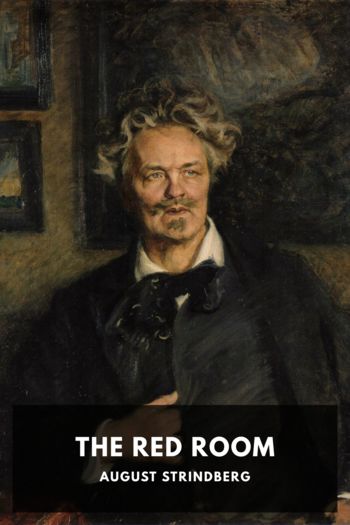The Inferno August Strindberg (story books to read txt) 📖

- Author: August Strindberg
Book online «The Inferno August Strindberg (story books to read txt) 📖». Author August Strindberg
The more one looks at it, the more lifelike and terrible it appears. Obviously, the spirits have become realists like the rest of us mortals. It is no mere accident, for on certain days the cushion takes the shape of terrible monsters, such as Gothic dragons and serpents; and one night after I have spent a hilarious evening, I am greeted on my return by a medieval demon, a devil with horned head and other appurtenances. I was not at all frightened; it looked so natural, but it also made on my mind the impression of something abnormal and unearthly.
When I invited my friend the sculptor to look at it, he was not at all astonished, and called me into his studio, where a pencil sketch hanging on the wall surprised me by its grace of outline.
“Where have you got that from?” I asked. “A Madonna, isn’t it?”
“Yes, a Madonna of Versailles, copied from the floating plants in a Swiss lake!”
A new-discovered art of nature! Naturalistic clairvoyance! Why blame naturalism when it introduces a new art full of capacities of growth and development. The old gods return, and the watchword of the poets and artists, “Back to Pan!” has roused such a strong echo that nature has awoken from her long sleep of centuries. Nothing can exist on earth without the concurrence of the powers. Now naturalism did once exist, therefore it ought to be, and what ought it obviously to be—a newborn harmony of matter and spirit.
The sculptor is a seer. He tells me that he has seen Orpheus and Christ side by side in a block of stone, and adds that he intends to return there and use them as models for a group for the Salon.
As I went down the Rue de Rennes one evening with the same seer, he drew my attention to a bookshop window where coloured lithographs were exhibited. They represented fantastic scenes with human bodies whose heads were replaced by pansies. In spite of my botanical observations, I had never before seen the likeness between the pansy and the human face. My friend seemed greatly surprised at it.
“Only think!” he said. “When I came home last evening the pansies in my window-box looked at me like so many human faces. I thought it was a hallucination of my overexcited nerves. And here are these pictures drawn a long time ago. It is then a fact and no illusion, for this unknown artist has made the same discovery before me.”
We make progress in the art of vision, and this time it is I who discover a Napoleon with his marshals on the cupola of the dome of the Hôtel des Invalides. When one comes from Montparnasse to the Boulevard des Invalides, one sees above the Rue Oudinot the cupola, the corbels, and cornices of the substructure of the cupola displayed in the full light of the setting sun, and apparently assuming human forms which appear more or less distant according to the point of observation from which they are viewed. There are Napoleon, Bernadotte, Berthier, and my friend copies them, “after nature.”
“How would you explain this phenomenon?” he asks.
“Explain? Has one ever explained anything by replacing one heap of words with another heap of words?”
“You don’t think, then, that the architect has worked according to a hidden plan?”
“Listen, my friend. Jules Mansard, who built the dome in 1706, could not well have foreseen the silhouette of Napoleon who was born in 1769. That is a sufficient answer!”
Often I have dreams at night, and these dreams prognosticate my future, warn me against dangers, and reveal to me secrets. For instance, a long-deceased friend appears to me in a dream, and shows me a piece of money of uncommon size. On my asking where this remarkable piece came from, he answers, “From America,” and disappears.
The next day I receive a letter from America from a friend whom I had heard nothing of for twenty years, informing me that an order in connection with the Chicago Exhibition had been following me in vain all over Europe. It carried with it an honorarium of 12,000 francs, an enormous sum for me in my desperate circumstances, which I could very easily find use for. This 12,000 francs would have secured my future, and no one besides myself would have guessed that the loss of this money was a punishment for an evil deed which I had committed out of anger at the treachery of a literary colleague.
In another dream of wider significance I saw Jonas Lie,6 with a gilt bronze clock curiously ornamented. Some days later, when I went to walk on the Boulevard St. Michel, a watchmaker’s shopwindow attracted my attention. “Jonas Lie’s clock!” I exclaimed aloud.
It was indeed the same. It was crowned by a celestial globe on which two female figures leaned; the works were supported by four pillars, and on the globe a date-indicator pointed to the 13th of August. In a future chapter I will explain what the fateful 13th of August brought with it. This and other occurrences took place during my stay in the Hôtel Orfila between 6th February and 19th July, 1896. Concurrently with them a larger adventure pursued its often interrupted course till, with my exit from the hotel, a new section of my life began.
Spring has returned; the valley of tears and sighs under my window is green and blossoming. Foliage hides the bare ground and its unsightliness. The Gehenna has turned into a Vale of Sharon full of lilies, lilacs, and acacias. I feel very melancholy, but the merry laughter of the





Comments (0)